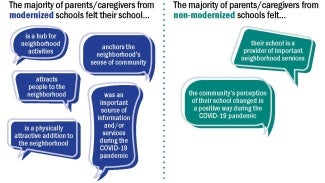
New study links modernized schools to better academic performance
Research shows that high-quality school environments can boost educational outcomes, improve well-being, and strengthen communities.
The amount of money available for public school maintenance has taken a steep dive since 2016, now amounting to a shortfall of about $85 billion every single year. What implications does this disinvestment have for teachers and students, who depend on these spaces to provide healthy and safe learning environments?
In new research supported by the AIA College of Fellows’ Latrobe Prize, in partnership with J+J Flooring, international firm Perkins Eastman sought to examine the non-monetary costs – including lower academic success – associated with neglecting to modernize schools. It gathered data from school buildings in Baltimore and Washington, D.C., school districts.
What is a "modernized school"?
“Modernized schools,” in the context of the study, meant facilities that had, within the last decade, received a major capital reinvestment with the goal of comprehensively updating or replacing program spaces, building systems, and furniture, fixtures, and equipment, as well as bringing the facilities into code compliance. Central to the researchers' intent was demonstrating to policymakers that addressing inadequate school facilities is an important and necessary step to supporting equitable education and community improvement.
“Though school districts across the nation are attempting to modernize their facilities as funding allows,” the report says, “when schools become outdated, students and teachers may be exposed to poor air quality, mold, inconsistent air temperatures, insufficient lighting, overcrowding, disorganized layouts, and other facility issues – all of which may be tied to an increased probability of lower academic success.” Research also suggests that schools with neglected infrastructure suffer from lower student attendance rates and higher drop-out rates.
The study, titled “Addressing a Billion-Dollar Challenge: Advancing Knowledge of How High-Quality School Environments Can Positively Effect Educational Outcomes,” is available now.
Researchers at Perkins Eastman used three metrics to guide their research: Indoor Environmental Quality (IEQ), Educational Adequacy (EA), and Community Connectivity (CC).

Environmental Quality
Modernized schools outperformed non-modernized schools in the key areas of thermal comfort, air quality, acoustics, and light.
An underheated or overheated school can impact students’ and teachers’ ability to focus – to teach and learn effectively. Air quality impacts overall health over time, while bad or poor lighting can serve as a distraction and hamper the function of an ideal learning environment.
Educational Adequacy
In the areas of school presence, building organization, sense of community, perceived safety, and more, modernized schools outperformed non-modernized ones.
Using a combination of live measurements of indoor environmental quality data, visual assessments, stakeholder questionnaires, and stakeholder interviews and focus groups, researchers were able to gather key metrics on how schools met their inhabitants’ educational needs.
Community Connectivity
Data supports the idea that modernization boosts school enrollment, as well as standardized test scores in mathematics and English language arts over time.
The researchers acknowledged that community connectivity can exist whether a school is modernized or not – but overall, modernization seemed to be a positive factor in supporting this phenomenon.
Recommendations:
The research team made a number of recommendations based on the study’s findings, including:
Improve the learning ambiance in instructional spaces.
The study demonstrated that large-scaled modernization efforts have considerable opportunity to create a positive learning ambiance, but when carefully planned, even small-scaled interventions in existing buildings can have a notable impact.
“A lack of investment in the building can be interpreted as a lack of care for the people who learn and work there, too,” the study says.
Consider how the community can engage with a school’s campus/grounds.
According to the study, green spaces like playgrounds, ballfields, running tracks, and other positive features can create opportunities for community members to benefit from a school modernization program, even if they never enter the building. This, in turn, may encourage increased community support for the school.
Recognize that modernization impacts community members differently.
The study’s authors caution that care must be taken to ensure that community members from across a wide demographic spectrum can benefit from school modernization. They also emphasize the importance of engaging long-time residents in the modernization process to mitigate the potential for gentrification, ensuring that they aren’t driven out of the school or neighborhood.
